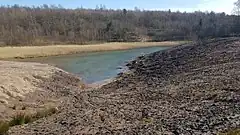Gram Natural History Museum
Gram Natural History Museum opened in 1976 in Gram in the Southern Jutland area of Denmark. It was located in Gram Palace until it was moved to a site next to the Gram Clay Pit in 2005. Once an independent museum, it became a part of the larger constellation of museums in Southern Jutland known as Museum Sønderjylland.
Naturhistorisk museum Gram | |
 | |
| Location | Lergravsvej 2, 6510 Gram |
|---|---|
| Type | Natural History |
Exhibits
The small museum focuses primarily on fossils found in the Gram Clay Pit, most of which are from animals such as the prehistoric megalodon shark Otodus megalodon[1] who died in the Gram Sea (the shallow sea that covered most of Denmark) 10 million years ago in the early Miocene epoch.[2]
The exhibit focuses in particular on whales and the evolution from land mammals to giants of the sea, as the remains of prehistoric whales have been found in the region. Of particular note is the discovery of a new species, Dagonodum mojnum, known as the Mojn-whale, named after the word for "goodbye" in the local dialect.[3] There are six other prehistoric whales known from the period. In addition, a discovery of a new whale specimen in 2007 is thought to be a new species, but evidence is still lacking.[4]
Gram Clay Pit
Visitors to the museum can explore the Gram Clay Pit and search for fossils themselves. They are welcome to take the more ordinary fossils they find home with them.
 The clay pit seen from the south end
The clay pit seen from the south end The area where guests are allowed to dig. The small fenced area marks the spot where the latest whale was found.
The area where guests are allowed to dig. The small fenced area marks the spot where the latest whale was found.
References
- Almgreen, S. E. Bendix (15 November 1983). "Carcharodon megalodon from the Upper Miocene of Denmark, with comments on elasmobranch tooth enameloid: coronoïn". Bulletin of the Geological Society of Denmark. 32: 1–32. CiteSeerX 10.1.1.514.1782. doi:10.37570/bgsd-1983-32-01. S2CID 53311833. NAID 10012345550.
- "Naturhistorie".
- "Næbhvalen fra Gram Lergrav er efter en skanning endt i videnskabeligt tidsskrift". ugeavisen.dk. November 25, 2019.
- Ramassamy, Benjamin; Lauridsen, Henrik (2019). "A new specimen of Ziphiidae (Cetacea, Odontoceti) from the late Miocene of Denmark with morphological evidence for suction feeding behaviour". Royal Society Open Science. 6 (10): 191347. Bibcode:2019RSOS....691347R. doi:10.1098/rsos.191347. PMC 6837206. PMID 31824732.